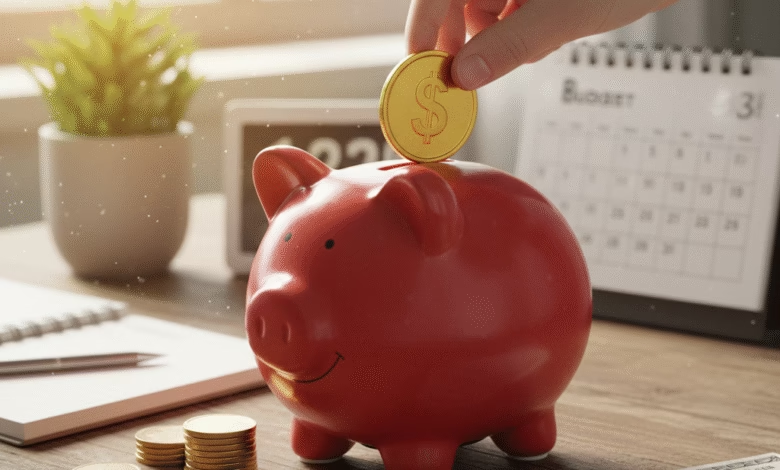5 Financial Mistakes Most People Make and How to Avoid Them
Discover these 5 mistakes that many people make and learn how to avoid them

Money is one of the biggest sources of stress in modern life. For many, it feels like a constant, unwinnable game—a cycle of working, paying bills, and falling just a little further behind. We see stories of people achieving “financial freedom,” but for the average person, that goal can feel hopelessly out of reach.
Here’s the truth: Financial success is rarely about a single brilliant move, a hot stock tip, or a six-figure salary. More often, it’s about consistently avoiding a few critical, common mistakes.
These mistakes are silent wealth killers. They don’t happen all at once; they’re small, habitual errors that compound over time, draining your bank account, stealing your peace of mind, and robbing you of your future.
The good news? They are all identifiable, understandable, and completely avoidable. This guide will break down the five most costly financial mistakes, the psychology behind why we make them, and a step-by-step plan to fix each one.
Mistake #1: Living Without a Budget (Flying Blind)

This is the foundational error from which all other financial problems grow. Living without a budget is like trying to drive across the country without a map or GPS. You’re moving, but you have no idea where you’re going, how much fuel you have, or if you’re even heading in the right direction.
What It Is: A “budget” is simply a plan for your money. It’s a conscious decision, made in advance, about where every dollar of your income will go. Living without one means you operate on “vibe” and bank-account-checking. You spend until the money is low, then panic, wait for the next paycheck, and repeat the cycle.
Why It’s So Damaging: When you don’t have a plan, you are ceding control of your life to your impulses.
- You have no idea where your money is really going. (Those $6 lattes and $15 lunches add up to hundreds per month).
- You can’t make progress on goals because you have no “leftover” money to allocate.
- You live with a constant, low-level hum of financial anxiety.
- You are perpetually one minor emergency away from a crisis.
The Psychology Behind It: People hate the word “budget” because it feels restrictive, like a financial diet. It sounds like spreadsheets and saying “no” to everything fun. In reality, a budget is the opposite: A budget is a permission slip. It gives you permission to spend on your “Wants” guilt-free, because you know your “Needs” and “Savings” are already covered.
How to Fix It (The Simple 3-Step Plan):
- The 30-Day Audit: You can’t make a plan if you don’t know your starting point. For one month, track every single dollar you spend. Use a free app (like Mint or Empower), a spreadsheet, or a simple notebook. This isn’t about judging; it’s about gathering data.
- Choose Your Plan: Once you know where your money is going, make a plan for where you want it to go.
- The 50/30/20 Rule: This is the best for beginners. You divide your take-home pay: 50% for Needs (rent, utilities, groceries), 30% for Wants (dining out, hobbies, streaming), and 20% for Savings & Debt Repayment.
- Zero-Based Budget (ZBB): This is for control-freaks (in a good way). You give every single dollar a “job” at the beginning of the month. Your income minus all your expenses, savings, and debt payments must equal zero.
- Automate and Forget: Willpower is a limited resource. Don’t rely on it. Set up your finances to succeed automatically. Have your “Savings” (Mistake #2 and #4) automatically transferred from your checking to your savings/investment accounts the day you get paid. This is “paying yourself first.” What’s left over is what you have to budget for.
Mistake #2: Ignoring the Need for an Emergency Fund
If you don’t have an emergency fund, you have a financial time bomb ticking in your life. This isn’t a matter of if an emergency will happen; it’s a matter of when.
What It Is: An emergency fund is a stash of cash—kept separate from your checking account—to be used only for true, unforeseen emergencies. This includes things like a job loss, a sudden medical bill, an urgent car repair, or a burst pipe in your apartment. It is not for a last-minute vacation or a holiday sale.
Why It’s So Damaging: Without an emergency fund, any unexpected event in your life becomes a debt event.
- Car breaks down? You put the $1,200 repair on a credit card.
- Lose your job? You pay your rent with a cash advance.
- Medical co-pay? You drain your checking and get hit with overdraft fees.
This is how people fall into Mistake #3. The emergency fund is the firewall between a bad day and a financial disaster. It breaks the cycle of debt and allows you to handle life’s curveballs without derailing your entire future.
The Psychology Behind It: We are naturally optimistic. We suffer from “optimism bias,” a cognitive bias that makes us believe we are less likely to experience negative events than others. We think, “It won’t happen to me,” or “I’ll just deal with it when it happens.” This is a catastrophic financial gamble.
How to Fix It (A Phased Approach):
- Phase 1: The $1,000 “Baby” Fund. For many, saving “3-6 months of expenses” sounds impossible. It’s too big a goal, so we never start. The first step is to aggressively save $1,000. Cut spending, sell stuff, work an extra shift. Get that $1,000 as fast as you can. This buffer is enough to stop 90% of small “life” emergencies from becoming debts.
- Phase 2: The Full Fund (3-6 Months). Once your $1,000 is secure (and after you’ve paid off high-interest debt—see Mistake #3), you can start building your full emergency fund. This should be 3-6 months of your essential living expenses. (Your “Needs” from the 50/30/20 budget: rent, utilities, food, transport).
- Where to Keep It: This money must be liquid (easy to access) but not too easy. Do not keep it in your checking account. Open a High-Yield Savings Account (HYSA) at a separate online bank. It will be out of sight, earn you much higher interest, but you can still transfer it to your checking in 1-2 days when needed.
Mistake #3: Carrying High-Interest Consumer Debt (The Wealth Destroyer)

This is the single most aggressive and destructive force working against your financial well-being. Carrying a balance on high-interest credit cards is like trying to swim upstream in a raging river.
What It Is: We’re not talking about all debt. A low-interest mortgage can be a tool to build wealth. We are talking about toxic, high-interest consumer debt: credit card balances, personal loans, and payday loans. The average credit card APR in the U.S. is over 20%.
Why It’s So Damaging: This is the dark side of compound interest. When you invest, your money makes money. When you have credit card debt, your debt makes debt.
- A Quick Example: Imagine you have a $5,000 balance on a card with 22% APR. If you only pay the minimum payment (let’s say $150), it will take you over 15 years to pay it off, and you will have paid over $5,400 in interest alone—more than the original amount you borrowed. You are working to make your credit card company rich.
The Psychology Behind It: Instant gratification. Credit cards are designed to separate the “joy of buying” from the “pain of paying.” It’s easy to swipe a card and tell yourself you’ll “pay it off later.” This “later” becomes “never” as the interest balloons.
How to Fix It (The Payoff Strategy):
- Stop the Bleeding: You cannot get out of a hole while you are still digging. Stop using your credit cards for new purchases. Switch to a debit card or cash until you are out of debt.
- Create a Payoff Plan: Choose one of two proven methods.
- The Debt Snowball (Psychological): List all your debts from smallest balance to largest. Pay the minimum on all but the smallest one. Attack the smallest debt with every extra dollar you can find. When it’s paid off, you feel a huge psychological win. You then roll that entire payment (the minimum + the extra) onto the next-smallest debt.
- The Debt Avalanche (Mathematical): List your debts from highest interest rate (APR) to lowest. Pay the minimum on all but the highest-APR debt. Attack that one with everything you have. This method is mathematically faster and will save you the most money in interest.
- Consider Your Tools: You may be able to accelerate this.
- Balance Transfer Card: If you have good credit, you can transfer your high-interest balance to a new card with a 0% introductory APR (usually 12-21 months). This pauses the interest, allowing 100% of your payment to go toward the principal. Warning: You must pay it off before the intro period ends, or the high interest kicks back in.
- Debt Consolidation Loan: A personal loan (with a lower, fixed interest rate) can be used to pay off all your credit cards at once. This gives you one single payment and a clear end date.
Mistake #4: Delaying Retirement Savings (Losing Your Best Ally: Time)
This is the most “silent” mistake because the consequences don’t show up for decades. But when they do, it’s devastating. The “I’ll start saving in my 30s or 40s” mindset is the most expensive financial decision you can ever make.
What It Is: Procrastinating on saving for your future. It’s assuming that you’ll “catch up” later by saving more. Unfortunately, the math doesn’t work that way.
Why It’s So Damaging: You lose your single greatest wealth-building tool: compound interest. Compounding is the “snowball effect” where your investments earn returns, and then those returns also start earning returns. Time is the fuel for this engine.
The “Cost of Waiting” Example:
- Saver A (Starts Early): Sarah saves $300 a month from age 25 to age 35 ($36,000 total invested). She then stops saving and just lets her money grow.
- Saver B (Starts Late): Ben saves $300 a month from age 35 to age 65 ($108,000 total invested).
- Assuming an 8% average annual return, by age 65:
- Ben (who invested 3x more): Has around $490,000.
- Sarah (who only invested for 10 years): Has over $780,000.
- Sarah’s money had 10 extra years to grow, and that “head start” was worth more than all the extra money Ben saved.
The Psychology Behind It: Present bias. Our brains are wired to value immediate rewards (spending $100 today) far more highly than future rewards (having $1,000 in 30 years). The future feels abstract, while the present is concrete.
How to Fix It (Start Now, Not Big):
- START. NOW. The single most important thing is not the amount, but the act of starting. Start with 1% of your paycheck if you have to. You can increase it later.
- The 401(k) Match: If your employer offers a 401(k) with a “company match” (e.g., “we match 100% of your contributions up to 5% of your salary”), you must contribute at least enough to get the full match. This is a 100% risk-free return on your money. It is free money. Not taking it is like declining a portion of your salary.
- Open an IRA: If you don’t have a 401(k) (or even if you do), open an Individual Retirement Account (IRA).
- Roth IRA: You contribute after-tax dollars. The money grows completely tax-free, and you pay no taxes when you withdraw it in retirement.
- Traditional IRA: You contribute pre-tax dollars (getting a tax deduction today). The money grows tax-deferred, and you pay income tax on it when you withdraw.
Mistake #5: Fearing Investments and Staying in Cash
After you’ve built your emergency fund, you may think you’re a great “saver.” But there’s a huge difference between saving and investing. Keeping all your long-term money in a savings account is a guaranteed way to lose.
What It Is: Keeping all your money (outside your emergency fund) in cash, checking accounts, or low-yield savings accounts because you are afraid of the stock market’s volatility.
Why It’s So Damaging: One word: Inflation. Inflation is the slow, steady increase in the price of goods and services. If your savings account pays 1% interest but inflation is 3%, your money is losing 2% of its purchasing power every single year. Your money is “safe,” but it’s safely losing value. You are saving the dollars, but losing the power of those dollars.
The Psychology Behind It: Loss aversion. Studies show that for humans, the pain of a loss is twice as powerful as the pleasure of an equivalent gain. We are so terrified of losing $100 in a market dip that we give up the much more likely prospect of gaining $1,000 over the long term.
How to Fix It (The Simple, Safe Way to Invest):
- Understand the Difference:
- Saving = Short-term (0-3 years), for specific goals (emergency fund, car down payment). Must be kept safe and liquid (like in an HYSA).
- Investing = Long-term (5+ years), for building wealth (retirement, college). Must be grown to beat inflation.
- You Don’t Need to Pick Stocks: The single best way for most people to invest is not to pick individual stocks (like Apple or Tesla). The best way is to buy the entire market.
- Use Index Funds or ETFs: An Index Fund (or Exchange Traded Fund – ETF) is a “basket” that holds tiny pieces of hundreds or thousands of companies. An S&P 500 Index Fund, for example, lets you own a small slice of the 500 largest companies in America. This automatically diversifies your risk.
- Practice Dollar-Cost Averaging (DCA): This is the antidote to fear. Instead of trying to “time the market” (which is impossible), you invest a fixed amount of money at regular intervals (e.g., $200 every month). When the market is high, your $200 buys fewer shares. When the market is low, your $200 buys more shares. This automates your investing, removes emotion, and lowers your average cost over time.
Putting It All Together: A Simple Path Forward

These five mistakes can feel overwhelming, but the fix is a simple, step-by-step process.
- Step 1: Create a Budget (Mistake #1). This is your roadmap.
- Step 2: Use that budget to save a $1,000 Emergency Fund (Mistake #2). This is your firewall.
- Step 3: Get your 401(k) match (Mistake #4). This is free money.
- Step 4: Attack your high-interest debt (Mistake #3). This is stopping the leak.
- Step 5: Finish building your 3-6 month Emergency Fund (Mistake #2). This is your security.
- Step 6: Aggressively increase your retirement investing (Mistake #4 & #5). This is building your future.
Financial health is not a sprint; it’s a marathon. You won’t fix all these mistakes overnight. The key is to stop being a passive participant in your own financial life. Choose one thing from this list. Start today. Your future self will thank you for it.





